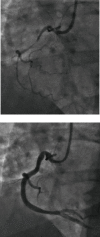Life-Threatening Coronary Vasospasm Treated by Implantable Cardioverter Defibrillator: The Warning Signs
- PMID: 35937136
- PMCID: PMC9348961
- DOI: 10.1155/2022/4504028
Life-Threatening Coronary Vasospasm Treated by Implantable Cardioverter Defibrillator: The Warning Signs
Abstract
Coronary artery vasospasm is the sudden narrowing of an artery caused by rapid prolonged contraction. It reduces blood supply to the heart and can present with typical cardiac chest pain symptoms. Vasospasm can lead to fatal arrhythmic complications such as ventricular fibrillation. Our case report describes an example of this occurring in a 53-year-old female, and the management plan that ensued. We look at the importance of accurate and prompt diagnosis of vasospasm and how this can have implications for treatment options. One of the available treatments for vasospasm is placement of an implantable cardioverter defibrillator (ICD). This delivers a shock in the event of future life-threatening arrhythmia, with the aim of preventing cardiac arrest. ICD placement, however, is not always a suitable option. This case report discusses the various challenges that arose while making the decision for ICD placement and gives insight into the best available treatment options for coronary artery vasospasm. We also highlight early warning signs that predict life-threatening vasospastic events and how this can be diagnosed and treated appropriately.
Copyright © 2022 Deborah Adepoju et al.
Conflict of interest statement
The authors declare that there is no conflict of interest.
Figures



Similar articles
-
Difficult management of a patient presenting with recurrent syncope caused by diffuse vasospasm.North Clin Istanb. 2018 Sep;5(3):264-267. doi: 10.14744/nci.2017.82160. North Clin Istanb. 2018. PMID: 30688936 Free PMC article.
-
Refractory Vasospastic Angina and Sudden Cardiac Arrest: Is Implantable Cardioverter Defibrillator Indicated and Is It Always Protective?Cureus. 2020 Aug 8;12(8):e9613. doi: 10.7759/cureus.9613. Cureus. 2020. PMID: 32789102 Free PMC article.
-
Multiple episodes of ventricular tachycardia induced by silent coronary vasospasm.J Interv Card Electrophysiol. 2008 Apr;21(3):223-6. doi: 10.1007/s10840-008-9207-4. Epub 2008 Feb 23. J Interv Card Electrophysiol. 2008. PMID: 18297382
-
Risk stratification for implantable cardioverter defibrillator therapy: the role of the wearable cardioverter-defibrillator.Eur Heart J. 2013 Aug;34(29):2230-42. doi: 10.1093/eurheartj/eht167. Epub 2013 May 31. Eur Heart J. 2013. PMID: 23729691 Review.
-
Should an implanted defibrillator be considered in patients with vasospastic angina?Arch Cardiovasc Dis. 2014 Jan;107(1):42-7. doi: 10.1016/j.acvd.2013.10.006. Epub 2013 Dec 25. Arch Cardiovasc Dis. 2014. PMID: 24373622 Review.
Cited by
-
Recurrent cardiac arrest and complete atrioventricular block due to idiopathic coronary vasospasm: A case report.Heliyon. 2023 Dec 16;10(1):e23766. doi: 10.1016/j.heliyon.2023.e23766. eCollection 2024 Jan 15. Heliyon. 2023. PMID: 38205299 Free PMC article.
References
-
- Swarup S., Patibandla S., Grossman S. Coronary artery vasospasm. StatPearls 2021. https://www.ncbi.nlm.nih.gov/books/NBK470181/ - PubMed
-
- Ishihara A., Tanaka T., Otsu Y., et al. Prognosis of patients with coronary vasospasm after successful resuscitation from ventricular fibrillation. Journal of Arrhythmia . 2012;28(2):105–110. doi: 10.1016/j.joa.2012.03.007. - DOI
Publication types
LinkOut - more resources
Full Text Sources

